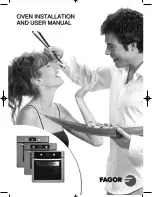
39
Roasting
Oven function: Conventional
or Rotitherm
Insert the grease filter when roasting!
Roasting dishes
•
Any heat-resistant ovenware is suitable to use for roasting (please read the
manufacturer's instructions).
•
Large roasting joints can be roasted
directly in the roasting tray or on
the oven shelf with the roasting tray placed below it.
•
For all lean meats, we recommend
roasting these in a roasting tin with a
lid.
This will keep the meat more succulent.
•
All types of meat, that can be browned or have crackling, can be roasted in
the
roasting tin without the lid
.
3
Tips on using the roasting chart
The information given in the following table is for guidance only.
•
We recommend cooking meat and fish
weighing 1 kg and above in the
oven
.
•
To prevent escaping meat juices or fat from burning on to the pan, we rec-
ommend placing some liquid in the roasting pan.
•
If required, turn the roast (after 1/2 - 2/3 of the cooking time).
•
Baste large roasts and poultry with their juices several times during roast-
ing. This will give better roasting results.
•
You can switch the oven off about 10 minutes before the end of the roast-
ing time, in order to utilise the residual heat.
Roasting table
Type of meat
Quantity
Ovenfunction
Shelf
position
Temper-
ature
°C
Time
Hours
mins.
Beef
Pot roast
1-1.5 kg
Conven-
tional
1
200-250
2:00-2:30
Roast beef or fillet
per cm. of
thickness
- rare
per cm.
of thickness
Rotitherm
1
190-
200
1)
0:05-0:06
- medium
per cm.
of thickness
Rotitherm
1
180-190
0:06-0:08
- well done
per cm.
of thickness
Rotitherm
1
170-180
0:08-0:10
Pork
















































